The City of Lee's Summit was founded as the town of Strother in 1865. In 1868, the city became the City of Lee's Summit and Marshall J. J. Craft became the city's first appointed marshal.
The Lee's Summit Police Department is fortunate to have a secretary in our Investigations Division that has worked in cooperation with the Lee's Summit Historical Society to prepare a history of the Lee's Summit Police Department since our humble beginnings. Below is a list of the previous marshals and chiefs that have served the citizens of Lee's Summit along with some pictures from the past as prepared by Nancy Caudle.
Marshal J. J. Craft was the first appointed marshal in the town of Lee’s Summit. His service started December 11, 1868. In April of 1869, he was then elected to the office and served through 1870. The population at the time was approximately 100 people. Josiah Collins was the Justice of the Peace and Post Master. The town was named Strother (pronounced straw–ther) when William B. Howard donated the land. On February 21, 1868, the name at the post office was changed to the Town of Lee’s Summit.
Marshal J. H. Stinson was elected to the position of Marshal from April 1871 through 1872. He was a house carpenter in the 1870 census.
Marshal Edd H. Smith was then elected April 1873 through 1874. He was a teamster in the 1870 census.
Marshal James A. Shaw was elected in April of 1874 and then re-elected in April of 1875. He also served as a constable and Justice of the Peace. He was a hardware merchant in the 1870 census. His office was located at the corner of 3rd Street and Market. Lee’s Summit had a beer house which occasionally had problems with patrons getting into fights after drinking too much.
Marshal James Near was elected in April of 1876. He was then re-elected in April of 1877 and then again in April 1878. The population had grown to around 700 people. With the town’s growth, Lee’s Summit was incorporated as a 4th class city. James Near was a house carpenter in the 1870 census.
Marshal James Inskeep was elected in April of 1879. Deputy Marshal Freeman was also there to assist. Inskeep was a butcher in the 1870 census.
Marshal James Madison “Matt” Short was elected in April 1880, re-elected in 1881 and then again in April 1892. The population had grown to 900. He was also the constable in 1899. Justices of the peace were John Boggs and Peter Mason. Sam G. Miller was the constable. Marshal Short was born in Kentucky in 1841 and came to Lee’s Summit in 1876. He fought in the Union army during the Civil War. During this time period (1885) fire consumed most of the downtown business district. 25 wood buildings were consumed. The marshal dealt with domestic violence issues. In 1882, the calaboose was located on a “forty foot lot at 3rd and Douglas. “The building was a 28’ by 30’ structure, built of native planks, laid flat over each other to form the outside walls. The building served several purposes. The north half was the jail and the south half was city hall. In the front was a cistern into which rain water from adjoining buildings emptied, providing a supply of water for firefighting.”
Marshal James Rollins was elected in 1887 through 1888. John Boggs was Justice of the Peace. Marshal Rollins’ office was located at 66 East Main, cor. Fifth.
Marshal Henry Jefferson Davis was elected in 1888
Marshal James Madison “Matt” Short was elected again in April of 1892 at the age of 50. He was also sexton of the cemetery. He addressed issues of domestic violence, running a gambling house without a license, kleptomania, swindlers, robbery and sneak thieves. There was also a matter of stealing hogs from the elevator pens. A dog poisoner was killing canines.
Marshal William B. Cooper was elected in 1894. His wife’s name was Mary and he had 5 children, Charles, Annie, Ernest, Joseph, and John. Marshal Cooper was the Street Commissioner in 1887. The population of the city had grown to 1,800, doubling from 900 citizens in 1880.

Marshal Fowlkes (unknown when elected) resigned from office on February 10, 1899.
Marshal T. B. Crooks was elected on April 7, 1899. James A Shaw was Justice of the Peace and James “Matt” Short was constable. Marshal Crooks also resigned, leaving the Marshal’s position vacant twice in one year.
Marshal R. W. Reece was elected marshal April 1, 1902 and remained through July 1902.
In a special election Wednesday, July 16, 1902, Marshal Henry Whaley was elected. He stayed in office until April 7, 1903.
Marshal J. S. Ritter was elected April 7, 1903. The population was approximately 2,000. The Night Watchman was Mr. Alexander. The election was held at the Gattrell building on West 3rd Street in the first ward and at City Hall in the second ward. The new city marshal and night watchman got new blue uniforms, with a blue helmet.
Marshal W. H. Whaley was elected to office Tuesday, April 5, 1904. (He was also elected Marshal in a special election held in 1902) He served until April 1905.
Marshal William Flanery was elected in 1905 and served through 1906.
On April 2, 1906, Tom Noland was elected to the office of city marshal. He was also elected April 7, 1914, and then again April 4, 1916 through 1918. The city marshal’s salary had been raised from $6.00 to $27.50 per month. The city was growing in leaps and bounds and there was a need for a system of water works for fire protection. A new city hall and calaboose were also needed. The citizens were lobbying for these improvements.
Marshal Jas. Inskeep was elected Tuesday, April 7, 1908. Having outgrown the old city hall that was built in 1869, it was to be torn down, leaving the city without a city hall and a calaboose. The city met in rented rooms and prisoners were taken to Independence. A new, two-story brick building was to be built on 3rd Street. The new city hall/jail was to be 21 ½ feet by 80 feet and be two stories high. The upstairs was leased by the M & K Telephone for 10 years. It was to have a solid glass front with white enamel brick leaded glass above the plate glass. The front was constructed of red pressed brick.
1909 brought a new law to Lee’s Summit, after August 15, 1909, it was against the law to carry a gun. The penalty was a fine from $100 to $1000 or a two year sentence in the county jail. Other new laws stated that boys under 18 years of age were not allowed to smoke cigarettes in any public place, and cigar dealers could not sell or give away to minors, cigarettes or papers for making them.
In 1909 a new steel cage was installed with barred windows on the west room in the Gattrell building for law breakers until the new city hall and calaboose could be erected. The new cage was of regulation style and size and was used in the new building. (The original Gattrell General Store burned in the 1885 fire and it can only be assumed they rebuilt).
Marshal Jas. W. Brown was elected April 5, 1910. He also served as marshal in 1911, 1912 – 1914, and then again 1932 – 1940. Todd M. George was appointed Justice of the Peace for Prairie Township on March 14, 1910. On April 22, 1910, the new city hall/calaboose was open for use. Lee’s Summit had about 25 automobiles in town. Marshal Brown dealt with peace disturbances and business burglaries. He received complaints of some indecency by swimmers in the Howard Park pond and persons were notified not to swim there during the daylight, under penalty of trespass and violation of city ordinances. It became a misdemeanor to skate on roller skates or coast on any of the business streets in Lee’s Summit. It was strictly prohibited by ordinance and Marshal Brown warned that the law would be enforced.
Marshal Thomas Noland was elected April 7, 1914. He was then re-elected on April 4, 1916 (serving two-year terms). Cam Jones was constable and the night watchman was Daniel Waller. The Night Watchman was instructed to ring the curfew bell each evening beginning Monday evening, July 13, 1914 and to enforce the ordinance concerning same. Marshal Noland was dealing with issues such as displaying the new 1916 license on automobiles, drunks on the streets from boot-legged whiskey in Lee’s Summit, and the Lee’s Summit Post Office safe being blown, with an explosion and $200 in money and stamps being taken. In August 1917, a $50,000 water works system was completed.
Marshal Henry J. Davis was elected on April 4, 1918.
Marshal Bryson Bowlin was elected in 1920.
Marshal Harvey Davis was elected in 1921.
On April 4, 1922 Marshal William Parrish was elected. W. C. Mills was night watchman and Henry Long was police judge. Parrish served until 1923. Marshal Parrish was paid a salary of $30.00, killing dogs $2.25 and cleaning the City Hall $2.00 for a total of $34.25. Night Watchman W. C. Mills was paid a salary of $25.00. Jas. W. Brown (former city marshal – 1912 – 1914) was paid $1.50 for taking a pauper to the poor farm. The Marshal was dealing with people shooting target guns, which by city ordinance was forbidden. Marshal Parrish stated that hereafter offenders would be punished. Someone in Lee’s Summit was selling booze. A meeting of citizens held at City Hall on Wednesday, April 4, 1923, discussed ways and means of stopping the bootlegging. In July of 1923, Marshal Parrish was ordered by the mayor and council to kill un-muzzled dogs found in the streets. Since those orders were put into effect, he had killed about twenty dogs. An Airedale pup was bitten and developed rabies, and another strange dog had run around town biting dogs, so hence the orders.
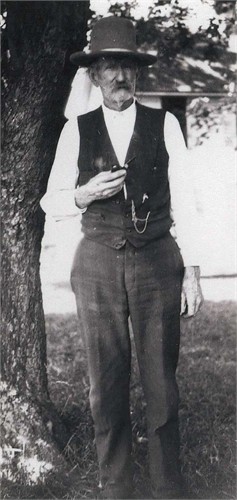 Marshall William Parrish
Marshall William Parrish
Marshal David Reed was elected in 1924 and then re-elected Tuesday, April 6, 1926. (He died while in office on 12-15-1926 at the age of 49) David Reed had also served as night watchman. The Justice of the Peace at this time was T. P. Gunn. While in office, Marshal Reed dealt with finding and arresting bootleggers. On March 20, 1924, Lee’s Summit’s Memorial Hall was packed when Rev. Carl C. Waler, an evangelist-healer, who was holding a twenty-two week series of meetings in Kansas City, delivered an address on “Americanism” under the auspices of the Lee’s Summit branch of the Ku Klux Klan. When the people arrived at the hall, they found Klansmen in full regalia forming a double line from the outer door of the auditorium with two robed men on duty on the walk in front of the hall. After an orchestra entertained the crowd, a collection of $103.92 was taken up and turned over to Allen Taylor, treasurer of the Memorial Association.
Marshal Lester Henry Mitchell was elected on April 5, 1927. He was re-elected on April 3, 1928. Marshal Mitchell also served as night watchman from 1930 through 1932. The population of Lee’s Summit was approximately 2,200. Marshal Mitchell had 13 children. In September, 1927, Charles Filmore consecrated Unity City (now known as Unity Farm/Unity Village) The City had 1600 acres on U. S. highway No. 50 and had oil and gas wells to furnish fuel and a lake that supplied water. In March 1928, the first gas well was lighting several blocks in Lee’s Summit. On July 4, 1929, speeding in the business section of town was on the increase and officers warned that there would be a serious accident if it didn’t stop. Arrests were to commence.
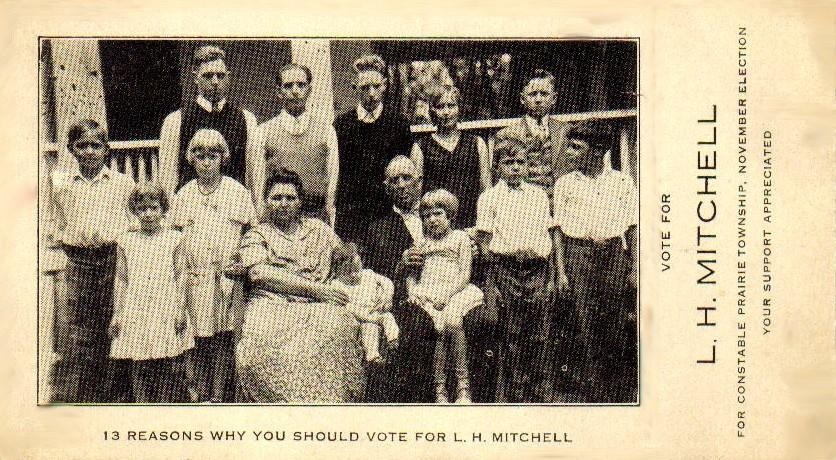
Marshal Cecil Brown was elected in 1930 and served through 1932. (This was during the years of the great depression) T. P. Gunn was Justice of the Peace. On April 22, 1930, during a meeting of the city council, the police department had a discussion regarding the state of un-cleanliness of the jail. Conveniences such as water, bedding, etc., were not adequate. Suggestions were made that the City Marshal should receive $100 per month and the night watchman should receive as much as $35.00 per month, and that the night watchman should have the privilege of collecting additional amounts of pay from merchants of the city.
On June 16, 1930, three new telephones to handle fire and police calls were installed by Southwestern Bell. They were located at 3rd and Douglas Streets, Third and Main, and Third and Market. They were in metal boxes, locked, so that they would be available to city officials only. No. “20” was assigned to the three telephones. Three keys were provided to city employees and each telephone was equipped with a loud gong so that it could be heard for a considerable distance. Under the new arrangements, anyone wishing to report a fire or call for police could call “20” from any phone in town. The operator then would ring “20” which would mean that the three gongs at the three locations would ring at once. The town marshal or anyone else authorized would answer the nearest of the three telephones and take the message. He would then summons any additional aid necessary.
July, 1930, was the first jailbreak in Lee’s Summit. A fire on the second floor of the Palmer Building on East Main, and a business burglary where the perpetrator was shot, for which Marshal Mitchell was to receive a special warrant of $10.00 for the capture of the burglar.
Marshal James R. Brown was first elected on April 5, 1932. He was re-elected April 3, 1934, April 7, 1936, and then again April 3, 1938. He served until 1940. In 1932, Buford Bowers was night watchman, who was appointed by the council. June 4, 1935 Roy Tucker was night watchman. On April 6, 1937, Roy Pace was appointed police judge. After only a short six month period, Pace resigned on October 5, 1937. In November 1932, Marshal Brown was instructed by the council to enforce parallel parking from Jefferson to Green Street, on Third Street, and from Second to Fourth Street on Douglas. In 1933, Marshal Brown, together with J. A. Myers, the constable of Prairie township seized a 500-gallon still with 40 gallons of whiskey, sixteen 100-pound sacks of sugar and thirty-four 200-gallon barrels of mash. On May 2, 1934, the council instructed Marshal Brown to proceed at once with the arrest of persons driving cars without city licenses. Marshal Brown dealt with other issues such as residential burglaries, and children riding bicycles at night when they couldn’t be seen. With the number of vehicles in Lee’s Summit rising, it was dangerous for them to be out after dark on a bicycle. On August 2, 1938, the city marshal and night watchman were given instructions, by the council, to enforce rigidly the ordinance pertaining to the closing hour for beer parlors and the weed ordinance. In December 1939, a Stop-and-Go Warning Light was installed at the intersection of Third and Douglas. It was suspended in the center of the intersection. The signal changed every 30 seconds and it was said that twelve cars could cross the intersection in the time between changes.
Marshal Jess N. Moore was elected on April 2, 1940. He was then re-elected April 7, 1942, April 2, 1944, April 2, 1946, and then re-elected April 1, 1947. He served through April, 1948. On April 8, 1940, Clint Havenhill was appointed night watchman. Aaron C. Preston was elected Police Judge and on April 1, 1947, Ira M. Ezzell was elected police judge. The population of Lee’s Summit was approximately 2, 263. On April 13, 1946, at the corner of 4th and Douglas Streets, was the Wilcox Service Station. My grandfather, Lee Kreeger (deputy marshal in the early 1940’s) said $200 in cash and checks were stolen after the glass in the front door was shattered and entry was gained. On June 13, 1946, two youth appeared before the police judge, Aaron Preston, and paid $11.00 for fines and court costs, in addition to receiving a 20 day suspended jail sentence, for breaking the city ordinance prohibiting the shooting of fireworks. One threw a firecracker into the entrance of the Vogue Theatre, located at 313 S. Douglas and another at the rear of Pete & Mary’s Café, 108 E. 3rd.
Marshal Clint Havenhill was elected April 6, 1948, winning by 63 votes over Jess Moore. He was then re-elected April 4, 1950, and then again on April 1, 1952. On January 1, 1953, he resigned citing ill health. Jess N. Moore was elected police judge (leaving his position as marshal), and then re-elected. Captain O. L. Viets was the auxiliary police chief for Lee’s Summit’s Civil Defense. Homer Davis was night watchman, elected in August 1951 and in January 1953. In April 1949, Marshal Havenhill received Lee’s Summit’s first “prowl car”. It was a 1931 Chevrolet coupe. The marshal was forced to use his personal vehicle as a city police car and was pleased to have the coupe even with its distinctive green color, so that he could take his personal car off the streets as much as possible. The citizens nicknamed this vehicle “The Green Hornet”, a popular radio and television masked vigilante created in 1936. In 1950, Lee’s Summit had 10 churches, 3 saloons, 7 secret societies, one of the best schools in the state, 1 meat packing house, 1 greenhouse, 2 harness shops, 3 barber shops, and a power print shop. The population of Lee’s Summit was approximately 2,554.
Vern Alley was appointed Interim Marshal after Havenhill resigned on January 1, 1953. Alley served in that capacity until April 7, 1953.
Marshal Herschel Davis was elected on April 7, 1953. He was re-elected April 6, 1954, April 5, 1955, April 3, 1956, and April 2, 1957. He served through April 1, 1958. During this time frame Jess Moore was police judge and Homer Davis the night patrolman. In 1957, Otto L. Viets was the radio operator. A radio was added to a police car for the first time. Parking meters had been installed to generate revenue and a patrolman was assigned the duty of enforcement of parking meter regulations. Another officer was hired as a full-time policeman in August of 1953, Dan Saunders. This raised the police force to three, with Homer Davis serving as night marshal. In January, 1955, the city council dealt with the possibility of hiring an additional officer and purchasing a second police car. Marshal Herschel Davis asked for a $25 increase in pay for the officers. They were informed that with the growth of the city they were considering a new patrolman and would not have enough money to grant the raise. On January 20, 1955, Charles “Red” Gardner was hired as the fourth member of the LSPD.
 Marshal Herschel Davis
Marshal Herschel Davis
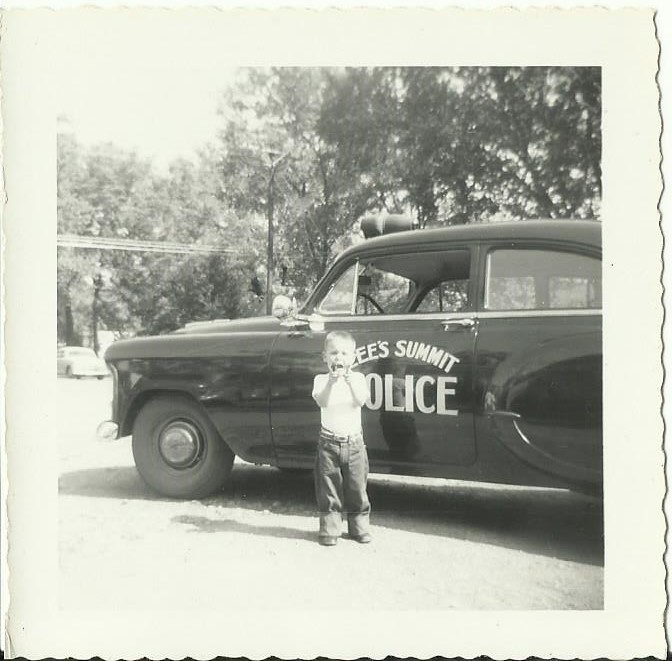
1954 Chevrolet Police Cruiser
In September, 1955, a radar equipped vehicle, on loan from the sheriff’s office, was set up to operate on West Third Street. As a result, 69 drivers were charged with speeding and one charged with careless driving. Their fines totaled $1,225.00.
In November, 1956, the city purchased a second hand 3-wheel motorcycle for Jack Hoskins, parking meter patrolman for Lee’s Summit. The cycle cost about $400.00 and was bought with money that came from the city’s parking meter fund.
The City of Lee’s Summit was experiencing growing pains and not only dealing with the needs of law enforcement, they were also dealing with the needs of the town. In March, 1954, a new sewer facility was opened. The city was inundated with requests from citizens to hook up to the sewer. 1955 - Lee’s Summit Cemetery Road was officially changed to Langsford Road. 1955 - The first polio vaccines were given to students in the R-7 School District. 1957 - A Direct dial telephone system was put into place, replacing 2-party lines. Parking meters, city stickers for vehicles, and city speed traps were in place to help with some of the costs.
On April 1, 1958, Otto L. Viets was elected as City Marshal. He was then re-elected April 5, 1960. He retired in 1961. The members of the Lee’s Summit Police Department were: Otto J. Ochs, Patrolman, Orville Slover, Sergeant, Jerry Anderson, Officer Trainee (May 1961), Robert K. Jones, Officer Trainee (May 1961), Kenneth Winburn, Radio Operator, Marion Skinner, Officer (resigned). Police Judge, Edmund M. Reardon and Councilman Vernon Winburn, in charge of police and fire.
The radio system was located in the City Collector’s Office and then moved to City Hall (located on Third Street) in April, 1958. By 1960, the population of Lee’s Summit had grown to 8,267, as compared to 2,554 in 1950. 5,713 more citizens to serve and protect.
New uniforms were purchased by Marshal Viets and the LSPD moved into a new office on the second floor of City Hall. A new police car was added to the department, giving a total of two 1958 cars in service. The city was struggling, finding expenses were mounting without corresponding revenue. Hard surfaced streets were replacing oiled roads.
Upon Marshal Viets’ retirement/leave of absence, Orville Slover was appointed as Acting Marshal on August 22, 1961. He had joined the LSPD in December of 1960. Within a few months he was promoted to Sergeant. Since the Western Electric plant had been constructed, and the population expanding, the infrastructure of the police department had to be addressed. Slover worked to acquire funding from the state and federal governments. With these funds, the LSPD was able to purchase new patrol cars, uniforms, and service revolvers that were needed.
 Acting Marshal Orville Slover
Acting Marshal Orville Slover
On April 3, 1962, Homer Davis was elected Marshal. He resigned in July of 1963. The members of the LSPD were as follows: Patrolman Terry Reynolds, Marshal Homer Davis, Patrolman Clarence Spooner, and Patrolman Jack Hoskins. Patrolman Jerry Anderson, Patrolman Albert L. Woodyard, Patrolman Kenneth Funston and Patrolman Donald Shaw. On July 19, 1962, an auxiliary police unit (reserves) was formed, composed of around 20 volunteers to assist with local law enforcement when needed and to assist civil defense authorities in the event of a disaster in Lee’s Summit. In April 1963, LSPD Headquarters was located on Main Street in the City Hall building (formerly the post office). In July 1963, Homer Davis resigned, was kept on as a patrolman until August, 1963, and a special election to fill the vacancy was to be held August 6, 1963. Nate Corder was appointed Acting Police Chief, from July 1, 1963 through August 6, 1963.
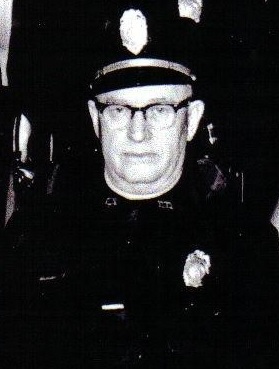 Marshal Homer Davis
Marshal Homer Davis
Albert L. Woodyard was appointed Interim Marshal from July 1, 1963 through August 6, 1963.
Marshal Al Woodyard
August 6, 1963, in a special election, Marshal Olen B. Curtis was elected. He remained until April 7, 1964. At that time, the Lee’s Summit Police Department was comprised of 6 patrolmen, 7 reservists, 4 radio operators, three council members (police board), the Marshal, and Secretary, Sallie Garvin Payne. There were four patrol units, with three marked cars and the fourth unmarked. All cars were radio-equipped.
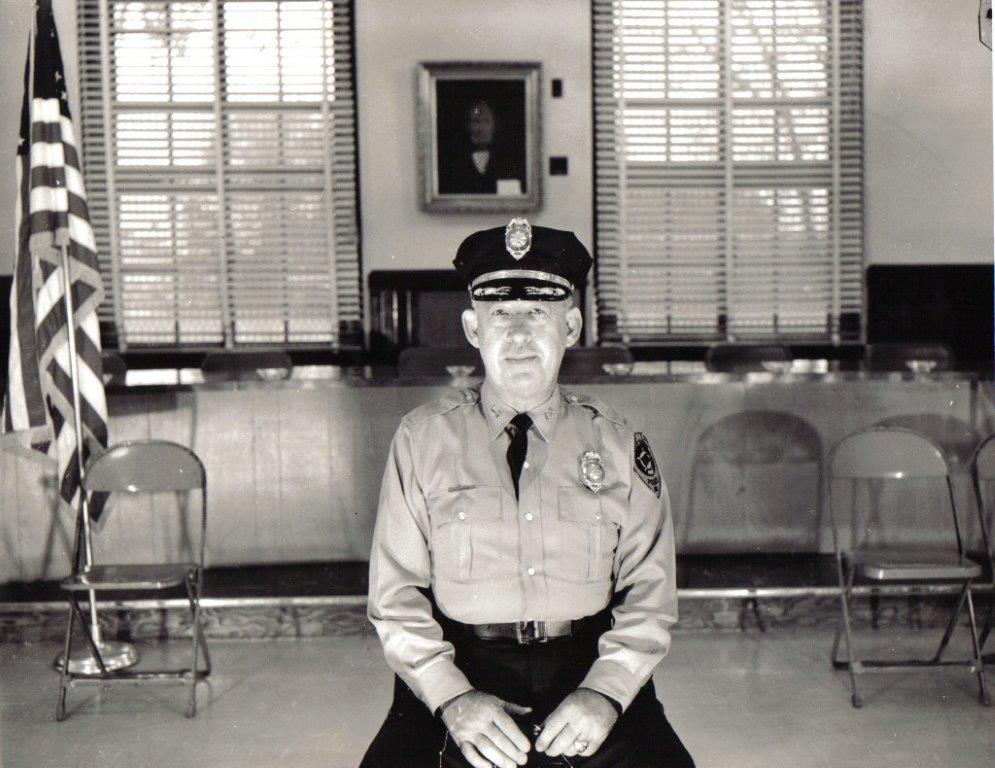 Marshal Olen B. Curtis
Marshal Olen B. Curtis
April 7, 1964, Marshal Donald E. Shaw was elected. He was suspended November 9, 1964, and then resigned November 15, 1964. The city council cited a pending investigation of certain information given to the mayor and councilmen as the reason for the suspension.
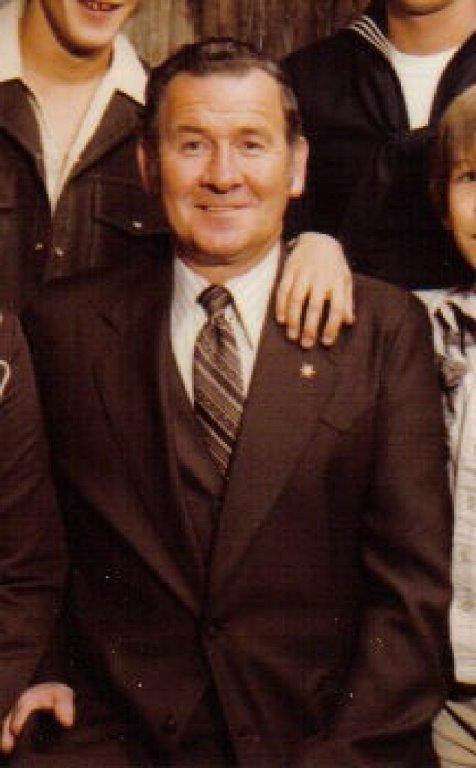
 Marshal Don Shaw
Marshal Don Shaw
November 15, 1964, Asa J. Steen was appointed Interim Marshal. He was then elected to the position of Marshal April 6, 1965 and remained until August 1967. Marshal Steen was the last city marshal as the position then became known as Chief of Police and was appointed by the city council instead of being elected into office.
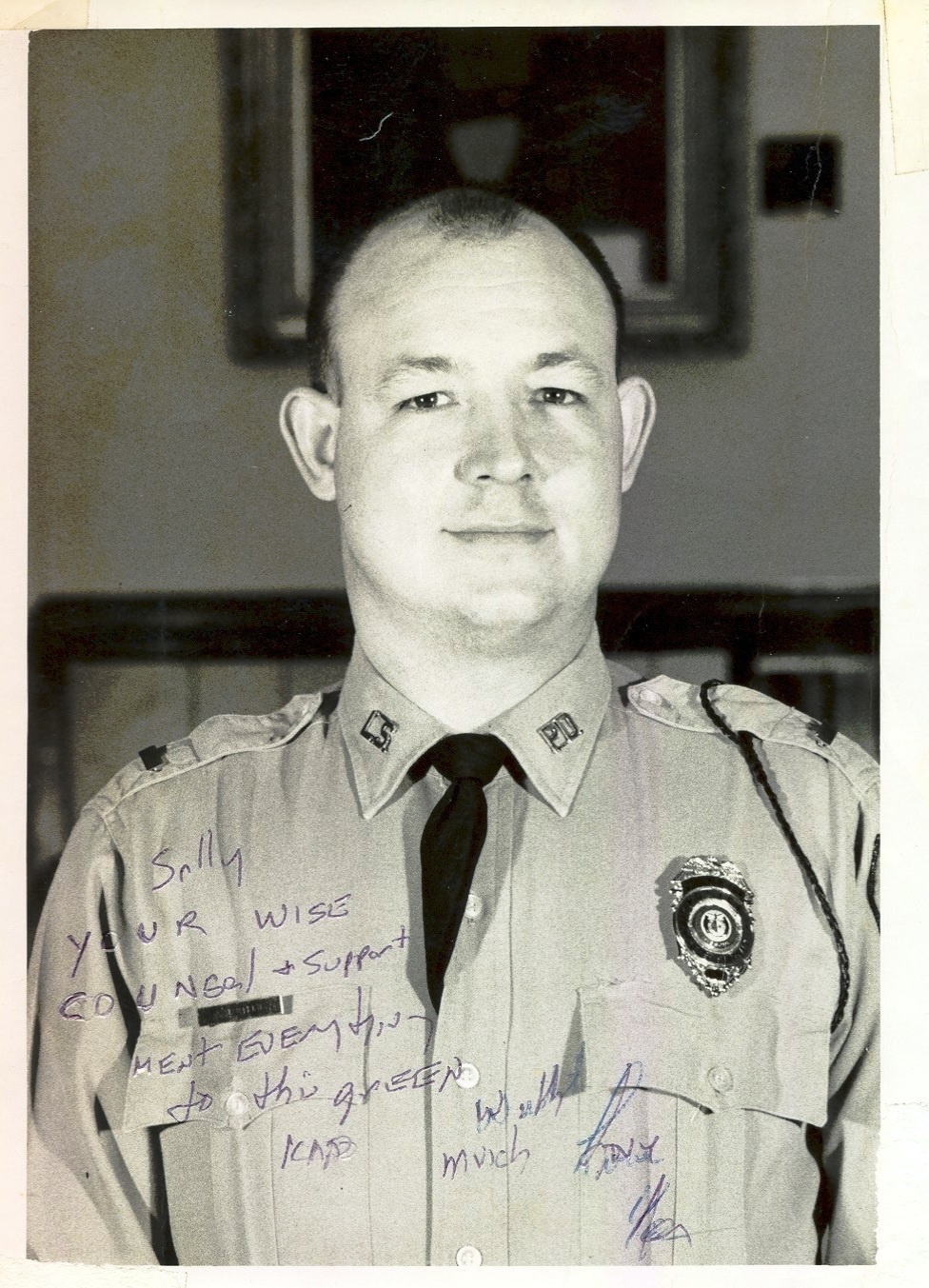 Chief Asa Steen
Chief Asa Steen

Marshal Steen and the Lee’s Summit Police Department were facing big issues. The department only had three police cars in 1964. They were patrolling 147,473 miles with these 3 cars. Another car was ordered, but it took manpower to operate 4 patrol units. Extra officers and a detective bureau were needed. The basic problem was that the city had outgrown its budget. Also, there had been newly annexed areas added to Lee’s Summit, and therefore more miles to patrol and added incidents. Radio reception was spotty the further north towards 40 highway and Bowlin Road. New radio communications equipment was needed. 4,277 overtime hours were logged in 1964 for which the officers were not paid. The officers were good about donating the time, which saved the police department. The crime rate was down in Lee’s Summit and the clearance percentage up in spite of the issues.
April 4, 1967, the citizens voted to make the city marshal position an appointed position rather than an elected one. City officials felt the change was necessary so the council could appoint a man who was professionally qualified in police work and as an administrator. The title of the office then became Chief of Police. Marshal Steen’s elected term had another year to go .
In August, 1967, Marshal Steen was to resign from his position as city marshal and the mayor and council appointed Lt. Donald L. Seneker to assume the position. Asa Steen was to become a lieutenant under Seneker. Chief Seneker remained until August 1969.
January 4, 1968 - The Lee’s Summit Police was in need of a new police building. They shared a radio system with the fire department and jail facilities were inadequate with no way to separate prisoners. In August 1968, an eight-part bond and park proposal was placed on the ballot on September 24, 1968, to include $275,000.00 for two new fire stations and fire equipment and $526,000.00 for a “tailor-made” police station, especially designed for police-work. The police building was to cost more than most buildings because it was not like any other building for commercial use. It was to have had sound-proof interrogation rooms, an inside pistol range, and jail cells designed for different types of prisoners. The bond passed. The future site of the building was located at 115 SE 2nd Street.
In May, 1969, the following members made up the Lee’s Summit Police Department: Chief Donald Seneker, Detective Samuel Moore, Patrolman Edward Trundle, Captain Oliver C. Roberts, Detective John Welsch, Sergeant Van Richie, Detective/Lieutenant Robert K. Jones, Sergeant Kenneth Francka, Corporal Gene Ramey, Patrolman Bill Parsons, Patrolman Henry Ellis, Patrolman Stephen Underwood, Patrolman James Clifford and Corporal Ronald Wilk.
Oliver C. (“O. C.”) “Bob” Roberts was appointed Interim/Acting Chief in August, 1969. He was then appointed Chief December 9, 1969 and worked in that capacity until April 6, 1971. He was terminated and subsequently fought the City for his job back. The Lee’s Summit Police Department consisted of the Chief, 14 officers, and police chaplain, 5 civilian personnel and 11 reserve officers, for a total of 31 employees.
On April 6, 1971, when it was time for Roberts’ re-appointment, in a stormy City Council session, he was ousted in a 4 to 3 vote. One council member immediately resigned. Roberts, visibly shaken challenged the three who voted against him, asking that they prove any allegations against him or the department. Mayor Johnson voted against Roberts’ re-appointment and made a call to George W. Pate to fill in as temporary Chief of Police. Pate once served as Commander of the Troop A, Highway Patrol in Lee’s Summit.
April 6, 1971, George W. Pate was appointed Interim Chief. He served in that capacity until June 15, 1971. In April, City Council sessions met with opposition from citizens bidding for Roberts’ reinstatement. The council chambers was jammed, giving the council members a petition that was signed by 2,000 people. It was declined on the grounds Roberts had a pending legal suit. In June, 1971, Judge J. Donald Murphy issued a writ of mandamus ordering the Lee’s Summit City Council to justify the dismissal of O. C. Roberts or to reinstate. A final ruling was to come in a few days. On June 15, 1971, O. C. Roberts was reinstated.
June 15, 1971, Chief Oliver C. “Bob” Roberts was appointed/reinstated to the position of Chief of Police of the Lee’s Summit Police Department.
In September, 1971, the new police building was ready for occupancy. In January 1971, the lower half was able to be used, which housed dispatch, the jail, and patrol/shift briefing. The upper half of the building housed court, the administrative offices, records, and the detective unit. Lee’s Summit was growing and some projected at that time, that within 7 years the population would increase to 70,000. In 1970 Lee’s Summit’s population was approximately 16,204. The police department/municipal court/and jail would remain in that building (115 SE 2nd Street) until January, 1999.
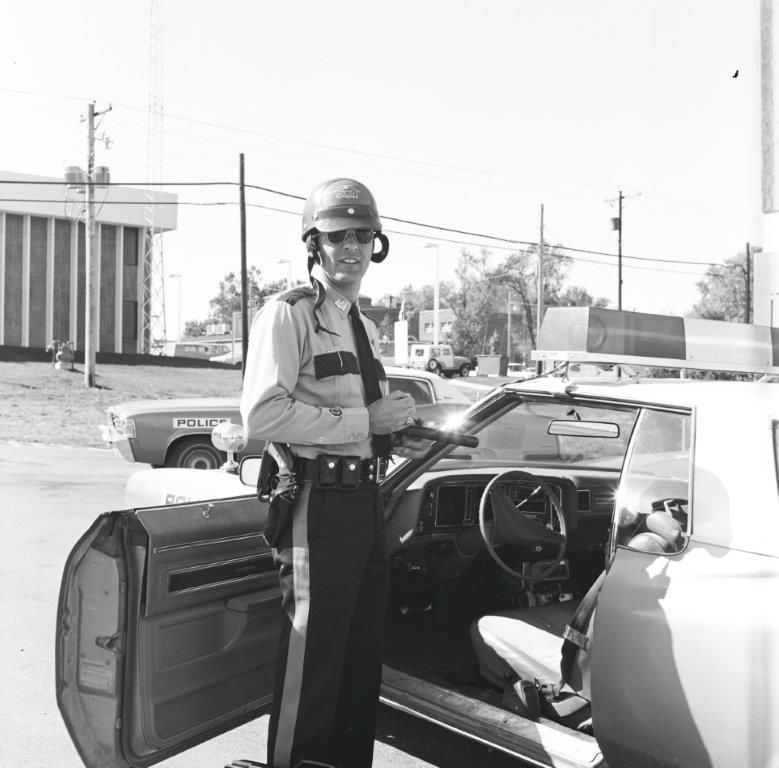
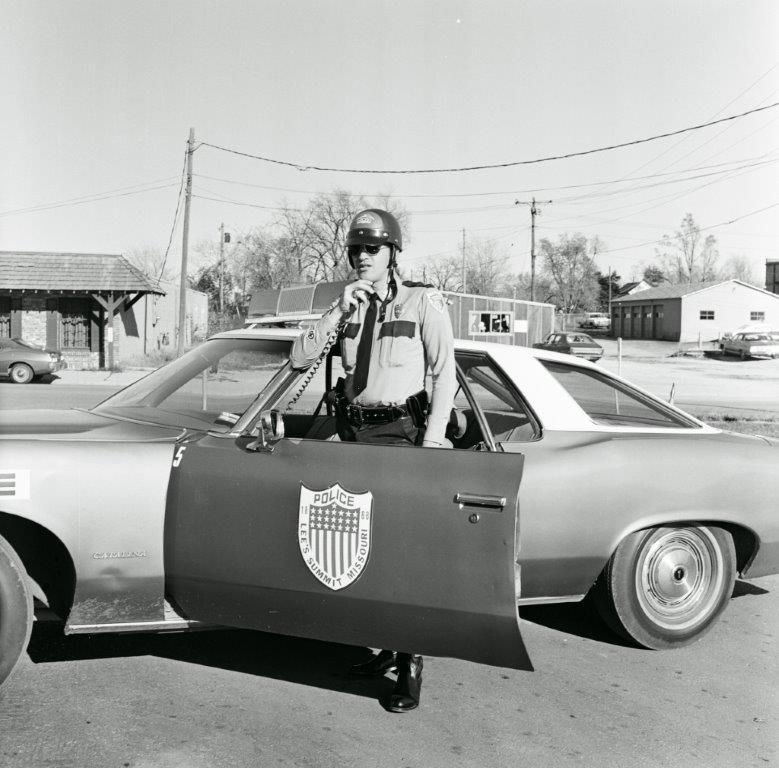
The department saw increased calls for service, so therefore were very busy. In October 1971, 16 fires were set by a serial arsonist. Murders, larcenies, thefts from autos, drug cases, and burglaries were also reported and dealt with during the early 70’s.
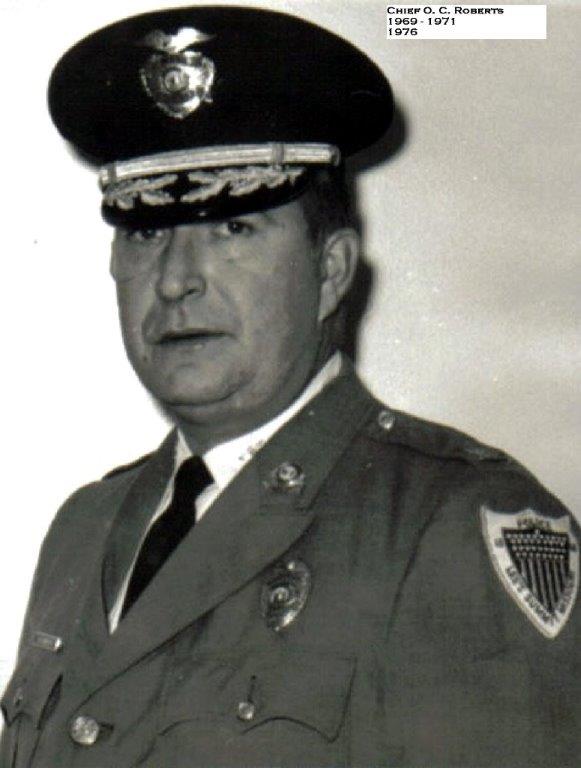 Chief O.C. Roberts
Chief O.C. Roberts
December 31, 1974/January 1, 1975 - Lee’s Summit, a small community of 14,000 people, experienced a heinous crime, when a man named James Love brutally murdered 14 year old Sheila Curtright, and 2 year old Jeffrey Berger, while she was babysitting.
April 13, 1976 – The Lee’s Summit City Council decided, during an executive session, to suspend Police Chief O. C. Roberts indefinitely. Captain Robert Jones was to become Acting Chief. O. C. Roberts had a stormy relationship with the City of Lee’s Summit from the start of his career. A series of incidents again brought Roberts’ position into question.
April 13, 1976, Robert K. Jones was appointed Interim Chief of Police. He served until August 17, 1976. The department investigated vandalism at the Lee’s Summit Cemetery, drug sales, robberies, and auto thefts. The formal removal of suspended Chief O. C. Roberts was announced on May 11, 1976 and the City of Lee’s Summit sent out an advertisement for a police chief, which drew more than 90 applicants. On August 17, 1976, Charles N. Leary of Urbana, Illinois was hired by telephone following an executive session of the City Council to be the city’s new chief of police.
 Interim Chief Robert K. Jones
Interim Chief Robert K. Jones
Charles “Chuck” N. Leary was sworn in August 23, 1976 as Chief of Police. He served until February 22, 1980. Instead of using the title of Chief of Police, Leary chose to use “Director of Police” He wanted to bring a different prospective to the make-up of administration and new ideas. There were 58 employees at the police department at this time and the population of Lee’s Summit was approximately 30,000. Leary reorganized the administrative structure of the department. He hired the first woman to be commissioned as a police officer in December 1976. Director Leary added a crisis intervention/short term counseling person to the department. Safety Town was born and grants were requested from the state for a model traffic program, which would add manpower, vehicles, and equipment needed. A growing issue with Lee’s Summit teenagers, solutions were sought to rid the city of vandalism, loitering, and traffic congestion caused by some of the youths in the downtown area. A curfew was discussed and parking ordinances, to help alleviate the issues. A merit for pay system was implemented by the City and opposed by the police and fire employees. The formation of the Fraternal Order of Police was thwarted and law suits filed against Leary and the city, by officers, because they felt coercion was used to dissuade the FOP’s reactivation. They also were opposed to the merit pay plan that had been implemented. Leary left the department in 1980 to become the Senior Law Enforcement Advisor to the Saudi Arabia Highway Patrol project.
David B. Mitchell was appointed Acting Director on February 22, 1980, and then Chief on May 20, 1980 through December, 1982. The population of Lee’s Summit, at this time (1980) was approximately 28, 742, up by more than 65% from 1970. Chief Mitchell began to make some needed changes. Officers were assigned permanent badge (identification) numbers. Four permanent patrol districts were created. Minimum manning was set at one supervisor plus five patrol officers, with the fifth officer floating as calls for services dictated. The entire city was divided into 50 report zones so that calls for service could be tracked and the information to be used to determine future patrol districts as the city grew. A career ladder was developed, but not implemented, for those officers who did not wish to move into supervisory positions. Additional training would be required to obtain a “master” level. The LSPD Policy and Procedures manual was formalized and reviewed on a continual basis to ensure officers operated within guidelines that kept pace with the changing laws. Chief Mitchell was the first officer at the LSPD to graduate from the FBI’s National Academy in 1982.
D. Greg Henderson was appointed Chief of Police in 1982. He served until 1994. He served the longest term as Chief of Police (12 years) to date. From 1982 to 1994, The Police and Fire Departments answered to a Department of Public Safety structure led by Kenneth Wright. In 1982 the Lee’s Summit Police Department’s roster showed 85 employees. In 1983, the first ESS – Emergency Services Squad was formed. Officer David Hartman, President of the Lee’s Summit Underwater Recovery Unit, died trying to rescue a man from the Little Blue River in Kansas City. This was the LSPD’s first, and remains the only, line of duty death. Officer Melvin Blunt was shot during a “routine traffic stop”. The 9-1-1 System was implemented at the LSPD on Valentine’s Day, February 14, 1983. In 1991, the LSPD received its first K-9 Officer, Caiy with Officer Mike Childs. The officers were dealing with burglaries, illegal drugs sales and usage, and armed robberies. There was a lack of adequate jail space. The Lee’s Summit jail would only hold 12 prisoners and was often filled to capacity. An expansion of Police Headquarters was essential for the future. In July, 1986, the population reached 40,000. This was a 39 percent increase from 1980. Lee’s Summit was to appear officially on the Missouri state map. In 1987, three new ZIP codes were added for Lee’s Summit. In 1987, the LSPD advertised for the first parking control officer to relieve officers from parking patrol duties. In July 1987, the LSPD’s Victims Assistance Program was established. In August, 1987, the Youth Court program was established upon approval of the Public Safety Advisory Board. In October, 1988, LSPD selected eight new officers to attend the police academy. Funding for the positions was approved by voters. The starting salary for a LSPD Officer was $18,646. The department had 60 positions allocated for sworn police officers for a community that was rapidly approaching 50,000 residents. In September, 1989, the city looked to expand or re-locate the Lee’s Summit Police Department (located at 115 SE 2nd Street at this time). Chief Henderson was entering into a long process of solving a serious space problem. As the city grew, so did the need for additional police officers. A fifth patrol district was created to reduce the area covered by each patrol car so that each area could be more effectively monitored. At a total cost of $64,000, the Board of Aldermen allocated funds to purchase guns for LSPD officers. All officers supplied their own weapons prior to this. The 1992 the roster of police employees registered 100. In July, 1992, Officer Mike Childs was shot during a scuffle with a suspected prowler. In 1994, Chief D. Greg Henderson retired after a long and illustrious 22 year career with the Lee’s Summit Police Department.
 Chief Greg Henderson
Chief Greg Henderson
Chief Daniel T. Rettig was appointed in 1994. He came from Coco, Florida. The department was re-organized into Bureaus and Sections. Community Oriented Policing (COP) was implemented. 1994 – saw the creation of the first Citizens Police Academy, January 31 thru April 4. Committee members included Bruce Trammell, Roger Brenner, Nancy Caudle, Rick Simpson, Chris Colon, Joe Piccinini, Rick Griggs, and Kim Corbett. The first class was on Daniel T. Rettig’s first day as Chief. 1994 – saw the First Awards Committee – establishing a policy for awarding officers and civilians. The committee consisted of Major Steve Underwood, Nancy Caudle, Lisa Kassell, Chuck Hutsler, Bill Oothout, and Vincent DiPalermo. Chief Rettig began the process for a new police building (later to be housed at 10 NE Tudor Road). Chief Rettig lost his position in 1996.

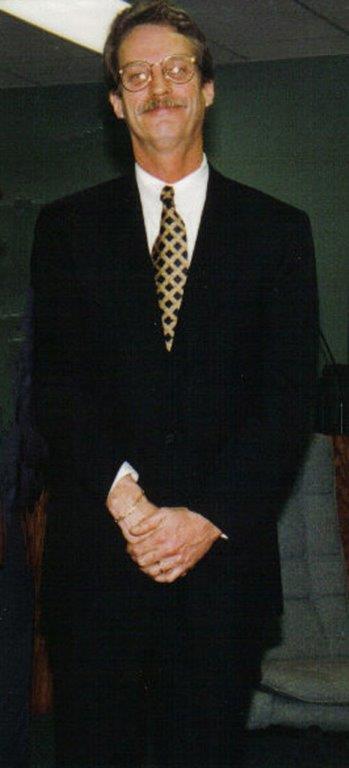 Chief Daniel T. Rettig
Chief Daniel T. Rettig
Major Stephen L. Underwood was appointed Acting/Interim Chief in July, 1996 while the City conducted a search for a new chief. He served through December, 1996 . Acting Chief Underwood spent 34 years with the Lee’s Summit Police Department, working in and commanding every aspect of the department.
 Interim Chief Steve Underwood
Interim Chief Steve Underwood
Kenneth T. Conlee was appointed as Chief in December 1996. He served the second longest term as Chief at the LSPD, retiring in 2007. He came from a law enforcement career in Iowa and also was Chief in Wentzville, Missouri, a suburb of St. Louis. The City of Lee’s Summit continued to grow with the estimated population in 2005 as 76,320. His accomplishments include: management of the construction of the new police/court facility located at 10 NE Tudor Road, on time and under budget. He was able to procure, through a tax levy increase, 34 ½ full-time positions for the department, increasing the staff by one-third. He obtained a $250,000 grant from the Violence Against Women’s Office of the Department of Justice for a community approach to domestic violence. He obtained outside funding, through grants and other partnerships in excess of $500,000. He reorganized the department. He procured grant funding for, and implemented School Resource Officers. He obtained funds to supply officers with in-car computer systems. He started the process for international accreditation for law enforcement. A bicycle patrol program was implemented. A Crisis Intervention Team was established to deal with and divert mentally challenged citizens from the criminal justice system. He participated in the proposal of a voter approved, bond funded, animal control shelter. A long-term financial model was created. Upon retirement from law enforcement, Chief Conlee went on to become the Jackson County Department of Corrections Director.

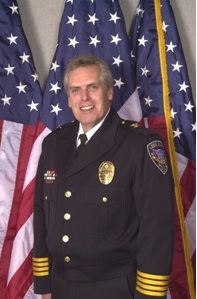 Chief Kenneth T. Conlee
Chief Kenneth T. Conlee
Major Joseph M. Piccinini was appointed Interim/Acting Chief November 2, 2007. In January, 2008, he was appointed Chief. The population had risen to 91,477 in 2011. The police department in 2008 was comprised of 117 sworn officers and 58 civilian employees, including animal control. Chief Piccinini initiated a “Community Policing” concept, lead the department to becoming a nationally accredited agency, expanded patrol districts from seven to ten and reduced Part 1 crimes (homicide, rape, robbery, etc). Chief Piccinini retired January 17, 2014.

 Major Joseph M. Piccinini
Major Joseph M. Piccinini
Interim Chief Scott Lyons was appointed January 17, 2014.
Chief Travis W. Forbes was appointed as Chief of Police on September 2nd, 2014. Prior to joining the LSPD Chief Forbes had a long and decorated career with the Independence MO Police Department. For more information on Chief Forbes, you can visit his staff page at the link below:
 Chief Travis Forbes
Chief Travis Forbes